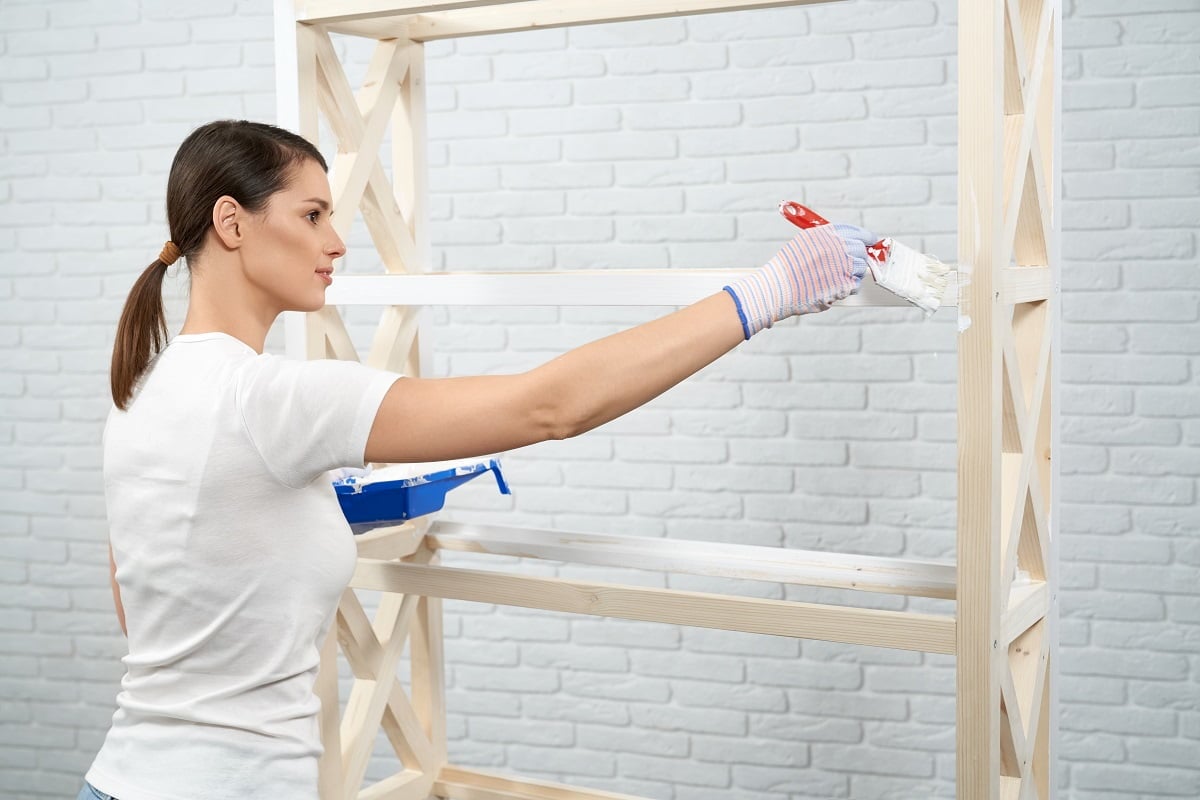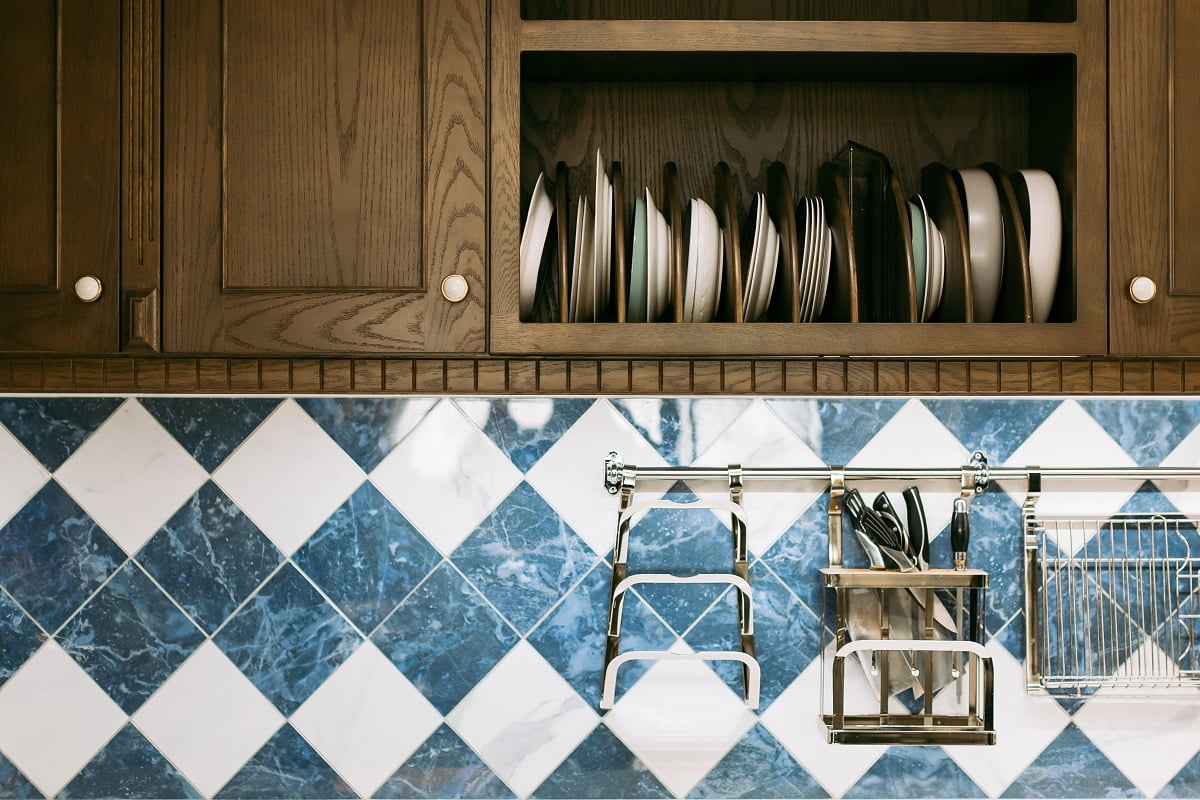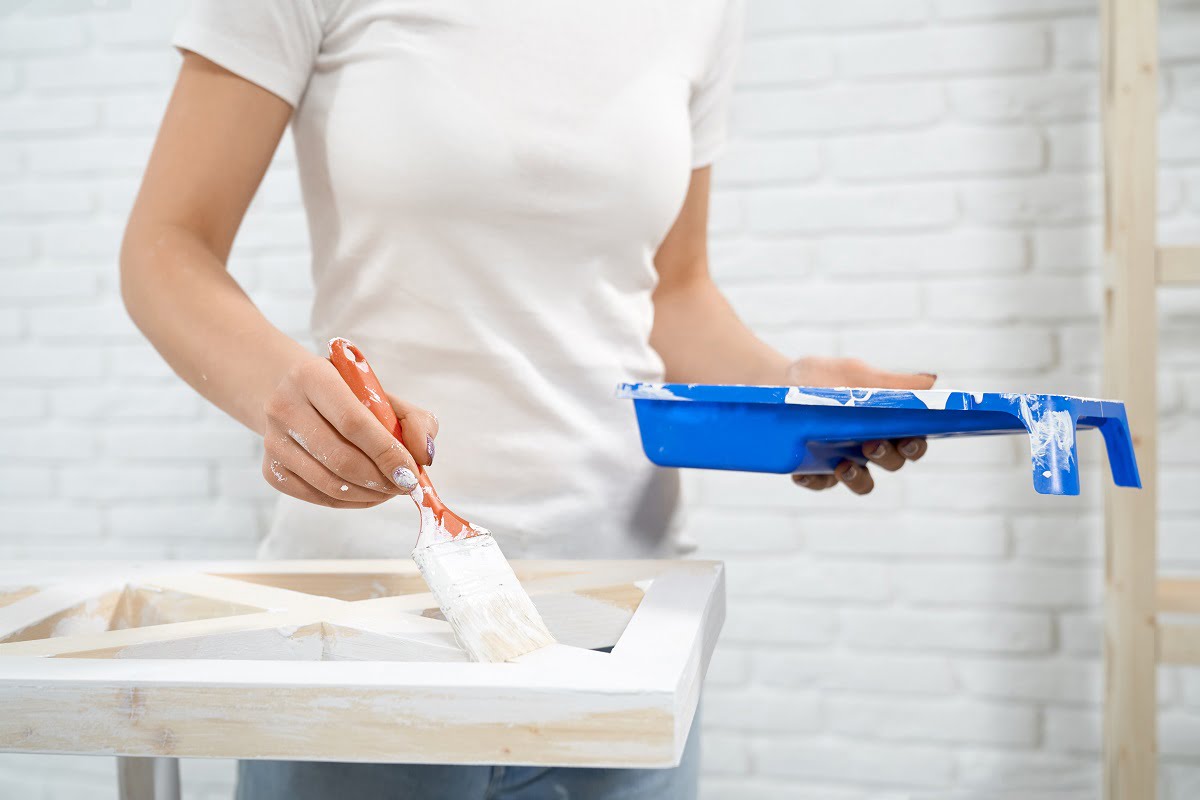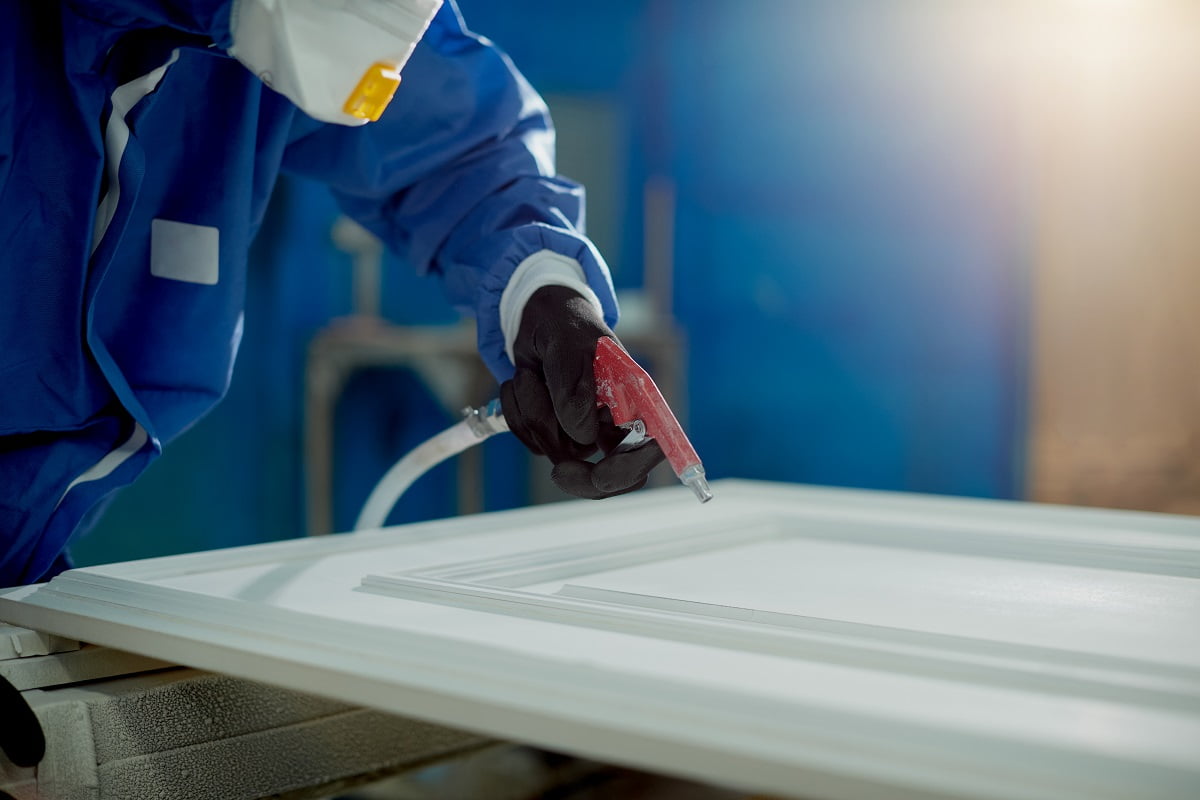Got a lot of old wooden furniture lying about in your household? Well, you can give them a fresh lease of life using paint for furniture.

Believe us, adding a fresh new coat of paint to furniture is great for giving it a new look, and if you follow through on that, you’ll be thanking us soon enough! Not only is it economical, but it is a sustainable choice as well.
For an experienced DIYer, undertaking such an endeavor can be a cakewalk since it is almost similar to any other painting task. You clean and sand the old furniture, apply primer, and apply the new paint coat.
However, if you are not as experienced in these tasks, then it might seem a bit complicated. That’s why we have presented a stepwise approach to painting wooden furniture in this guide for all of you inexperienced folks out there.
So, jump in!
Things You’ll Need
Before you get started with the job, it is important to gather the necessary tools. Surely, you would not want to scramble for supplies halfway during the task, would you? It will disrupt the workflow and might affect the final outcome.
That is why we have listed below all the tools and equipment needed so that once you start the job, you can finish it without any unnecessary interruptions.
- Sanding papers
- Brushes
- Foam rollers
- Painter’s tape
- Screwdriver
- Plastic bags
- Soapy water
- Buckets
- Drop cloth
- Personal protective equipment (masks, goggles, and gloves)
- Tack cloth
- Wood fillers
- Primer
- Wood paint
- Sealant
How To Paint Wooden Furniture?

The process of painting wooden furniture is relatively straightforward. If you use a systematic procedure, you can get it done within a day or two and with minimal mess.
So, here are the steps that you should follow.
Step 1: Remove The Drawers And Other Detachable Parts
Most wood furniture comes with drawers, handles, and other detachable parts. You will need to paint these components as well. But you cannot do that if they are attached to the furniture.
That is why the first step is to remove the detachable hardware from the furniture. Some of these components, such as drawers, come with a sliding mechanism which makes them easy to remove. But for other parts, such as detachable doors, knobs, handles, and latches, you will need to put in some extra effort.
Using a screwdriver, carefully remove the screws that hold these components in place. Once you have done that, pull out the parts and place them in a plastic bag separately for the time being. Also, make sure not to misplace the screws, or else putting them back together can be problematic.
Step 2: Put Down A Drop Cloth
Next, you will need to put down a drop cloth over the floor. We would recommend covering the entire floor of the room without any gaps between the floor and the room. Then you will need to place the furniture in the middle of the drop cloth, away from the walls.
This will ensure that the paint does not splatter all over the ground or the walls. Instead, all the paint will splatter over the drop cloth, which is relatively easy to dispose of compared to performing an extensive cleanup of your floor and walls.
Step 3: Mask Off Areas That Won’t Be Painted
If you are planning to paint only some parts of the wood furniture, then you will need to mask off the parts that won’t be painted in this step. Using painter’s tape, carefully seal off the portions that you won’t be painting.
Make sure there is no gap between the taped areas, or else the paint might seep in. In this regard, we suggest applying the tape in an overlapping manner, which eliminates all gaps.
Step 4: Wipe The Wood Surface
Before painting wood furniture, you will need to wipe it. This will get rid of any loose dust particles or grime on the wood, which can mess up the paint finish.
To do this step, you will need to wipe the wood surface with a damp tack cloth. For best results, you can use a soapy solution to moisten the tack cloth before wiping. Make sure to wipe the whole surface evenly and allow it to dry once you are done.
On a side note, you should put on protective equipment, such as goggles, gloves, and masks, in this step and keep them on for the rest of the process.
After you are finished, do not dispose of the soapy water, as it will be required again during the next step. So, for the time being, put the bucket of soapy water and the wiping cloth aside, and continue on to the next step.
Step 5: Sand And Clean The Wood Furniture
In this step, you will be required to sand the entire surface of the wood furniture. This will make the surface smooth and prepare it for painting. Furthermore, if you use painted furniture, this step will help to get rid of the old paint.
This is arguably the most tedious step, and it generates a lot of dust, so you need to be patient and use proper protection throughout. Initially, you should use low to medium grit sandpaper, like 60 grit or 80 grit, to scrape off the old paint and remove any flaking or peeling on the wood.
Eventually, you can move to high-grit sandpaper, such as 220 grit or 240 grit, to make the surface smooth and even. If the wood is already in good condition, very light sand will be sufficient. Too much sanding, in this case, may wear off the surface considerably, which is not desirable.
The time taken for the whole sanding process may vary depending on how much surface needs to be covered and the furniture’s condition. From our experience, sanding large pieces of wood furniture takes roughly a few hours.
In any case, we suggest you avoid rushing through this step if you want the best results. After you are done, you need to wipe the surface with a tack cloth once more to remove any loose wood grain.
Another thing to keep in mind is that sanding should only be done for solid wood furniture and not laminate furniture. The laminated surface may become damaged, even if you lightly sand it. For such furniture, simply wiping the surface with a damp cloth will be enough.
Step 6: Fix Any Irregularities
This is a short and optional step that involves finding and fixing any surface irregularities on the furniture, such as cracks or holes. It needs to be done only for furniture pieces that are very old or are made from raw wood.
To do this, you will need to examine the surface thoroughly. If you notice any irregularities, you can fix them by applying some wood filler paste over the spot with a putty knife. After that, lightly sand and wipe the spot to remove any excess filler and make the surface even.
Step 7: Prime The Surface
Next up, you will need to apply a suitable primer to the surface of the furniture. This will prepare it for the painting process by improving the adhesive properties of the surface. That way, the paint will stick to the wood better, and you will get a long-lasting finish.
Normally, we recommend applying a thin coat of primer to achieve the best results. This can be achieved if you apply one or two coats over the furniture surface. Any more than that may make the primer coat too thick, which will ultimately make the painting process difficult. Not only that, applying a thick primer coat is pretty wasteful.
On that note, make sure to dry the first coat of primer before applying the second coat. If you wish, you can lightly sand the primer before the second coat with a fine 240 grit or 320 grit sandpaper. That will give it a slight texture that will not only enhance paint adhesion but will also improve its appearance.
Step 8: Paint The Furniture
After you are done applying primer, it’s finally time to start painting! Dip the paintbrush or the roller in the wood paint, shake off any excess, and carefully apply it over the surface. Use even strokes throughout to avoid any unsightly lap marks.
Ideally, we recommend using a foam roller to paint the larger areas. Using a foam roller will help you to avoid drips and splatters. But for painting smaller or hard-to-reach spots, you can use a brush. Painting these areas requires precision strokes, which are easier to do with a paintbrush. Besides, the large head of a roller won’t be able to reach such small areas anyways.
You can apply multiple thin coats of paint to get a more prominent color and a professional finish. However, make sure to allow the paint to dry completely before applying the following coat. This is crucial and should not be rushed, or you will end up with an uneven or sloppy paint finish.
After you apply the top coat, allow it to dry for a few hours. During this time, you can try painting the detachable hardware, such as the handles, knobs, and doors. These should be painted with a fine brush so that any uneven brush marks can be avoided. Moreover, with such a brush, you can better paint any details and engravings if they are present.
Step 9: Apply Sealant And Varnish
This is an optional step that can help protect your furniture better in the long run. The sealant contains compounds that bind with the paint to give you a durable and flawless finish.
Usually, the sealant is applied on a freshly painted surface for the best result. Likewise, the paint needs to be fully dry to proceed with this step. If you apply the sealant on wet paint surfaces, the color will become botched.
To give your painted furniture a glossy finish, you can apply a varnish over the top coat. Varnishes are typically made from polyurethane compounds and are available in a variety of sheens, such as matte, semi-gloss, and high gloss. So, pick whichever suits your tastes, and apply it to your furniture. After that’s done, you need to dry it before proceeding further.
Step 10: Put The Furniture Back Together
Once the painting and sealing process is done, you should reattach the existing hardware, such as handles, knobs, and doors, to the furniture piece. But first, you should make sure that the paint on these components is dry.
Alternatively, you can replace the older pieces with new parts, provided the new components are compatible with your furniture. If you plan to do this, you won’t need to paint the old parts. But we would still suggest you keep them stored away, just in case you need spares later on.

Types Of Paints For Furniture
If you want to paint furniture, the type of paint is an important aspect to consider. In that context, there are different types of paints that can be used for this purpose, each with its own set of characteristics. We have discussed each of these paint types below, so if you are curious about them, keep reading.
1. Latex Paint
One of the most versatile options for painting furniture is latex paint. This type of paint is readily available from any hardware store and is quite cheap to boot. What’s more, it is available in a wide range of finishes and colors that allow for a greater degree of personalization.
It can be easily washed with soap and water, which is a bonus, especially if you want to repaint your furniture down the line. However, one disadvantage of this paint is that it takes a long time to cure. That can be inconvenient if you want to put your newly painted furniture to use quickly.
2. Chalk Paint
This is another worthy option that you can use to paint wood furniture. Chalk paint is one of the most popular choices for giving a new life to old wood furniture. This is because of its thick and luxurious finish that enhances the appeal of any furniture piece considerably.
It can adhere well to any surface, which makes it versatile. And it has a quick drying time, so that is a major advantage. But on the flip side, this paint is comparatively expensive, which can deter many people from choosing it over other options.
3. Milk Paint
As the name suggests, this paint uses a milk base along with a lime or borax activator. The biggest merits of this paint are that it is completely non-toxic and highly eco-friendly. On top of that, it is a relatively affordable option for painting wood furniture.
It is usually available in powder form, which means you need to add water accordingly to achieve the desired thickness. However, this can cause some inconsistencies with the finish, which is a major drawback of this paint.
4. Mineral Paint
Mineral paint uses inorganic colorants combined with a mineral-based binding agent. The mineral binder is non-toxic and provides an excellent quality finish. It is fully waterproof and extremely durable as well, so it is a great choice to paint wood furniture with.
That said, it cannot be used on all surfaces, which makes it less versatile in comparison. And it is not as readily available as latex or chalk paints either.

How To Paint Wooden Furniture Frequently Asked Questions ?
We understand that you may have some questions in the back of your mind, such as “can you paint furniture with acrylic paint?” or “how long does wood paint last?”. That is why we have discussed some of the most frequently asked questions in this section, so that you can put your mind at ease.
Can you paint furniture with acrylic paint?
Yes, you can reliably paint wood furniture with acrylic paint. Such paint contains acrylic resins in a water-based solvent, which adheres really well to wood. However, acrylic paint is sold in small quantities, so it is feasible only for small-scale painting projects.
Is oil-based paint good for wood furniture?
Oil-based paint is quite suitable for wood furniture, given the fact that it does not require sealants or varnish to make it durable. It does take a very long time to cure, though, which can make it a bit inconvenient for this purpose.
How long does wood paint last?
If you are talking about the shelf life of the paint, then most wood paint can last anywhere between 5 to 10 years if unopened. But if you are referring to the lifespan of the paint coat on furniture, then that depends on several factors, such as the type of paint, usage frequency, and maintenance.

How To Paint Wooden Furniture Final Words
Painting your old wooden furniture can considerably liven up your rooms. Besides, it is a way more feasible option than buying brand new furniture every few years, wouldn’t you agree?
Of course, we understand that painting your furniture might not be easy if you are inexperienced. You may not know the proper paint techniques for furniture. And you may make mistakes like rushing through the process, forgetting to wear protective gear, or applying paint coats that are too thick.
Thankfully, if you follow our stepwise guide, you can complete this task with relative ease and minimal errors. So, the next time you are planning to paint furniture, we hope that you will put this guide to good use.
And now, we have arrived at the end of this brief guide. Keep an eye on this space for more updates in the future.
Until then, goodbye!
